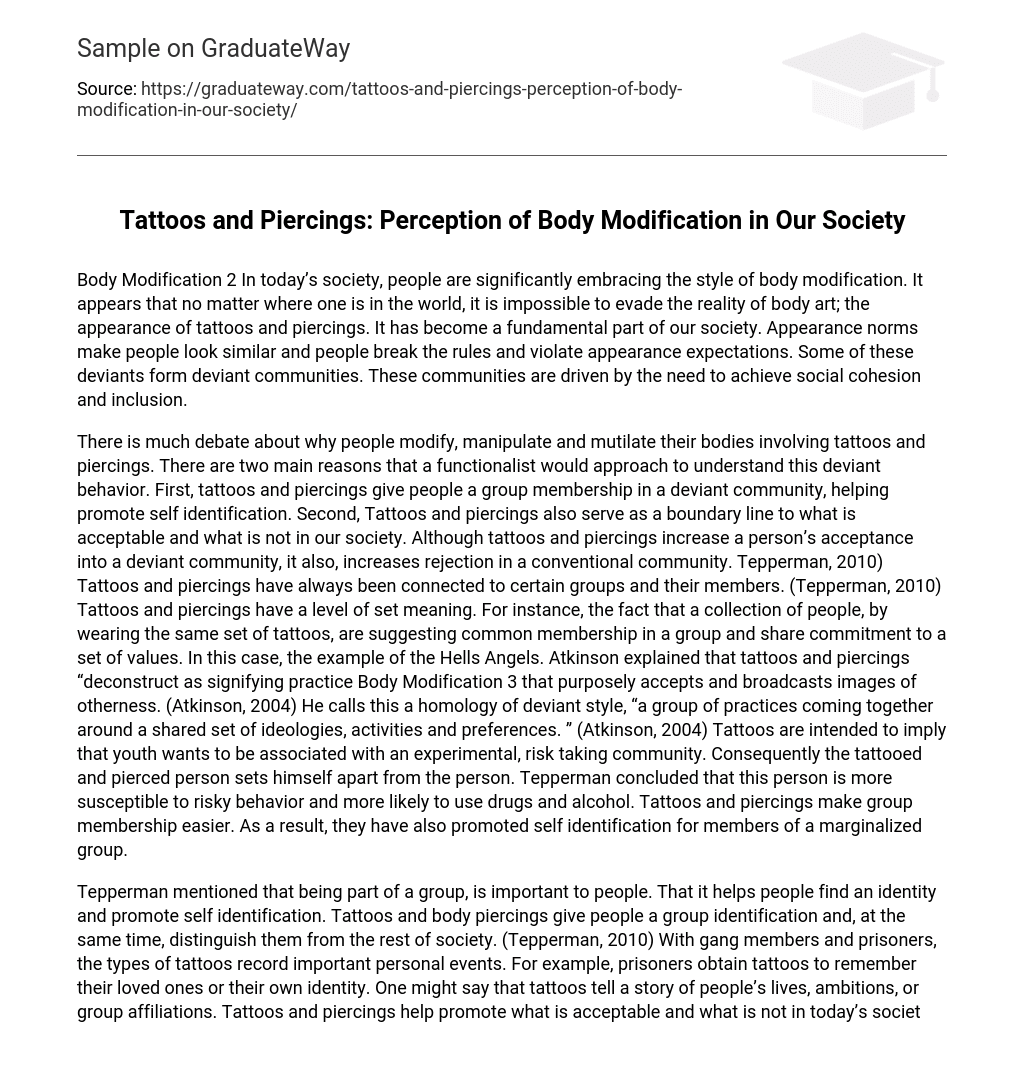Body Modification 2 In today’s society, people are significantly embracing the style of body modification. It appears that no matter where one is in the world, it is impossible to evade the reality of body art; the appearance of tattoos and piercings. It has become a fundamental part of our society. Appearance norms make people look similar and people break the rules and violate appearance expectations. Some of these deviants form deviant communities. These communities are driven by the need to achieve social cohesion and inclusion.
There is much debate about why people modify, manipulate and mutilate their bodies involving tattoos and piercings. There are two main reasons that a functionalist would approach to understand this deviant behavior. First, tattoos and piercings give people a group membership in a deviant community, helping promote self identification. Second, Tattoos and piercings also serve as a boundary line to what is acceptable and what is not in our society. Although tattoos and piercings increase a person’s acceptance into a deviant community, it also, increases rejection in a conventional community. Tepperman, 2010) Tattoos and piercings have always been connected to certain groups and their members. (Tepperman, 2010) Tattoos and piercings have a level of set meaning. For instance, the fact that a collection of people, by wearing the same set of tattoos, are suggesting common membership in a group and share commitment to a set of values. In this case, the example of the Hells Angels. Atkinson explained that tattoos and piercings “deconstruct as signifying practice Body Modification 3 that purposely accepts and broadcasts images of otherness. (Atkinson, 2004) He calls this a homology of deviant style, “a group of practices coming together around a shared set of ideologies, activities and preferences. ” (Atkinson, 2004) Tattoos are intended to imply that youth wants to be associated with an experimental, risk taking community. Consequently the tattooed and pierced person sets himself apart from the person. Tepperman concluded that this person is more susceptible to risky behavior and more likely to use drugs and alcohol. Tattoos and piercings make group membership easier. As a result, they have also promoted self identification for members of a marginalized group.
Tepperman mentioned that being part of a group, is important to people. That it helps people find an identity and promote self identification. Tattoos and body piercings give people a group identification and, at the same time, distinguish them from the rest of society. (Tepperman, 2010) With gang members and prisoners, the types of tattoos record important personal events. For example, prisoners obtain tattoos to remember their loved ones or their own identity. One might say that tattoos tell a story of people’s lives, ambitions, or group affiliations. Tattoos and piercings help promote what is acceptable and what is not in today’s society.
All classes of people are getting tattoos, from gangs and prisoners to teachers and doctors to youth who just turned 18. Tattoos and Body Modification 4 piercings used to be considered low class or dangerous symbols but now are beginning to be defined as trendy and glamorous. These visible boundaries, appearance norms, make it harder to enforce standard behavior from non standard behavior in a community. (Tepperman, 2010) In essence, tattoos and piercings strengthen social cohesion by making a clearer distinction between the people who violate appearance norms and people who do not.
Atkinson suggested that tattooing predicts more serious deviance, that individuals who brutally mutilate their bodies in such a way possess other primitive or non normative impulses. Such deviant appearances, such as tattoos piercings are recognized mainly to youth as impulsive and irrational. Atkinson states that tattoos and piercings indicate immaturity with youth who are at risk and is connected with forms of self harm such as physical aggressiveness, promiscuity, substance abuse and suicide. Atkinson believes that the relationship between tattoos and piercings and illegal behavior have subculture groups such as prisoners and youth gangs.
Deviating society’s norms, such as getting tattoos and piercings, are guaranteed to have consequences. There are two main categories of consequences: social consequences and health consequences. Thorstein Veblen would argue that tattoos and piercings are what he calls conspicuous waste. Veblen explains that [Tattoos and piercings] are a waste of time and effort Body Modification 5 and a waste of goods. Tepperman states that the result of such a waste could “result in frustration and disappointment…a high rate of expenditure of wasteful goods and services. (Tepperman, 2010) Tattoos and Piercings can be very dangerous for hygienic reasons. Tattoo guns and piercings needles can infect the part of the body that is being handled. Tepperman points out that diseases may be acquired from unsanitary practices. In deduction, people must also take appropriate measures to healing procedures to prevent infection and disease. In conclusion, the main functionalist approach to understanding tattoos and piercings are structural. Today’s society is in a tattoo renaissance. No matter where you go, tattoos and piercings, a form of body art, is impossible to escape.
Tattoos and piercings are now becoming an essential part of our society. Appearance norms build similarity and people break these norms and violate appearances. As a result deviant communities begin to form. These communities are motivated to achieve social unity and enclosure. There are many reasons why people get tattoos and piercings. The two main reasons that a functionalist would approach to understand this deviant behavior are: First, tattoos and piercings create group membership therefore promoting self identification. Secondly, tattoos and piercings create a boundary to what is acceptable in society and what is not.
Even though tattoos and piercings may increase a person’s acceptance into a deviant community, it at the same time increases rejection in a traditional community. (Tepperman, 2010) Body Modification 6 Tepperman, Lorne. (2010) Deviance, Crime and Control: Beyond the straight and narrow. Don Mills, Ontario: Oxford University Press. Atkinson, Michael (2004) “Tattooing and civilizing processes: Body modification as self control” Canadian Review of Sociology and Anthropology, The http://findarticles. com/p/articles/mi_go2771/is_2_4/ai_n7338944/? tag=content;col1





